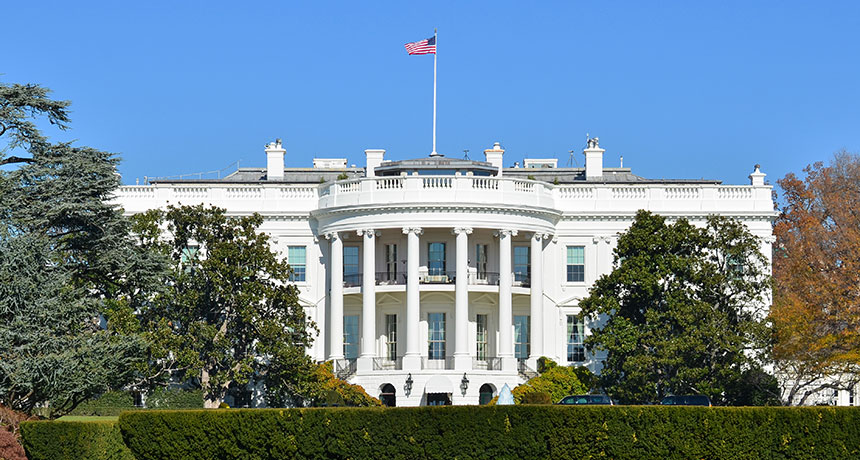White House budget plan would slash science
Fiscal 2018 proposal calls for deep cuts in spending for EPA, NIH and other agencies

SHOW ME THE MONEY President Donald Trump has released his budget request for fiscal year 2018. It includes deep cuts to some federal science agencies including the Environmental Protection Agency and the National Institutes of Health, but other agencies, such as NASA, emerge relatively unscathed.
orhancam/iStockphoto
- More than 2 years ago
Huge cuts could be in store for federal science spending if President Donald Trump’s vision for fiscal year 2018 becomes reality.
Although details are skimpy, Trump’s $1.15 trillion budget proposal, released March 16, would make national security the top priority. The budget blueprint calls for a $54 billion increase in defense spending for 2018, offset by an equally big reduction in nondefense activities. Among the biggest science losers are the Environmental Protection Agency, which could see its budget shrink by 31 percent compared with 2017, and the National Institutes of Health, which faces an 18 percent spending slash. The Department of Energy’s Office of Science could lose about 17 percent of its funding while DOE’s Advanced Research Projects Agency-Energy, or ARPA-E — which supports research on promising energy technologies — faces complete elimination.
The bare-bones budget blueprint leaves out figures altogether for many science-related agencies. It doesn’t even mention, for example, the National Science Foundation, a major source of federal funding for basic research across scientific disciplines. NSF is currently operating on a $7.5 billion budget. Full breakdowns aren’t available for most departments, so there’s no information on what’s to come for such programs as the National Institute of Standards and Technology (part of the Department of Commerce), the U.S. Fish and Wildlife Service (part of the Department of the Interior) and the Defense Advanced Research Projects Agency, or DARPA (part of the Department of Defense). More details for these and other omitted agencies may be included in a full budget proposal that the White House expects to release in May.
The White House’s budget outline is already raising alarm in the scientific community. “Major national goals are served by these investments in science and technology,” says Matt Hourihan, director of the R&D Budget and Policy Program at the American Association for the Advancement of Science in Washington, D.C. The proposed cuts, he says, “would set back our scientific leadership and would set back our technologies.”
Story continues after table
Proposed 2018 budget
Here are the president’s proposed FY2018 budgets for select science agencies in $ billions. Numbers are not adjusted for inflation, which is predicted to be 2 percent in 2018.
| Agency | 2017 (continuing resolution) |
2018 (president’s request) |
Change (2017 to 2018) |
|---|---|---|---|
| NASA | 19.2 | 19.1 | -1% |
| NIH | 31.7 | 25.9 | -18% |
| EPA | 8.2 | 5.7 | -31% |
| DOE Office of Science | 5.3 | 4.4* | -17% |
*Estimate based on reported $900 million cut.
Ultimate authority of the budget rests with Congress. Last year, Congress failed to reach agreements on fiscal 2017 spending; the government has been operating under a continuing resolution that has largely kept agencies funded at their 2016 levels. That resolution expires April 28. But if the House and Senate can find common ground for fiscal 2018, which begins October 1, they are likely to be kinder to science than Trump was, Hourihan predicts. “Overall, Congress tends to find ways to support science and technology.”
Leland Cogliani, a lobbying consultant with Lewis-Burke Associates LLC in Washington, D.C., who specializes in DOE policy, agrees. “There’s a lot of angst and concern and worry about these proposed cuts to federal agencies as a whole,” he says. “My discussions with appropriators is that this budget is dead on arrival.” — Erin Wayman, with additional reporting from SN writers
EPA • NIH • DOE • NOAA • NASA • USGS • CDC• FDA
Environmental Protection Agency
Trump’s proposed budget would devastate the EPA, dropping its annual budget from $8.2 billion to just $5.7 billion. The agency’s workforce would shed about 3,200 of its approximately 15,000 employees.
EPA’s scientific research arm would lose roughly half of its annual funding, dropping to about $250 million. Those cuts would threaten activities such as STAR grants, which provide research money and graduate fellowships in the environmental sciences.
“Unless we can find a backstop for those cuts from universities or the private sector, this is going to have a devastating impact on the global ability to do a lot of the basic science on environmental issues,” says Andrew Light of George Mason University in Fairfax, Va., a former senior adviser to the State Department’s U.S. Special Envoy for Climate Change.
In total, the budget blueprint targets more than 50 EPA programs for elimination, including the Energy Star program for boosting efficiency in appliances as well as restoration efforts to clean up the Great Lakes and Chesapeake Bay. — Thomas Sumner

National Institutes of Health
The president’s budget proposal would slash $5.8 billion from the $31.7 billion the NIH currently receives. Supporters of biomedical research call the proposal “disastrous” and say such deep cuts will topple the United States from its position as the world leader of biomedical research. “We’re not going to be No. 1 anymore. We’re going to slide down to the bottom of the pile,” says Jennifer Zeitzer, director of legislative relations at the Federation of American Societies for Experimental Biology, headquartered in Bethesda, Md.
Singled out in the budget proposal was the Fogarty International Center, which Trump wants to eliminate entirely. The center operates on a roughly $70 million budget and supports international collaboration for research and training in global health and infectious diseases.
“I think this is extraordinarily wrongheaded and dangerous,” says Chris Beyrer, an AIDS researcher at Johns Hopkins Bloomberg School of Public Health. Eliminating the center “is really a threat to the health and well-being of American people.” — Tina Hesman Saey

Department of Energy
DOE as a whole faces a 5.6 percent cut in Trump’s proposal, dropping it from $29.7 billion to $28 billion. The cut “falls disproportionately on the basic research and applied energy programs,” says Cogliani.
DOE’s Office of Science would lose about $900 million, coming from both cuts to the DOE and changing priorities for the agency. Currently funded at $5.3 billion, the Office of Science oversees 10 national labs and funds basic physics and energy research at over 300 schools in the United States.
Another DOE office, the Advanced Research Projects Agency-Energy, or ARPA-E, would get scrapped entirely. ARPA-E backs new energy technologies that show promise but aren’t far enough along to garner private sector funding. ARPA-E supports scientists working on nuclear fusion, for example, as well as new types of batteries.
One bright spot for the DOE is a call to increase funding of the National Nuclear Security Administration, which helps ensure the safety and efficacy of the U.S. nuclear weapons stockpile. — Laurel Hamers
National Oceanic and Atmospheric Administration
No specific budget request is included for NOAA, part of the Department of Commerce. NOAA, which monitors short- and long-term changes in the world’s oceans and atmosphere, is currently funded at $5.8 billion. The blueprint does, however, include targeted cuts that would eliminate more than $250 million for coastal and marine management, research and education. Those cuts include completely defunding NOAA’s $73 million Sea Grant program, which supports university-based research programs promoting the conservation and practical use of coastal and marine areas.
Other NOAA programs wouldn’t be hit as hard. The National Weather Service appears to avoid any major cuts, and the budget proposal maintains the development of current-generation weather satellites, including the Joint Polar Satellite System and the Geostationary Operational Environmental Satellite programs. — Thomas Sumner

NASA
NASA’s proposed slice of the pie for fiscal 2018 is $19.1 billion — down 1 percent from 2017, before accounting for inflation.
“I think NASA’s top-line budget for 2018 is favorable,” says planetary scientist Alan Stern of the Southwest Research Institute in Boulder, Colo. “I bet there are many agency heads who would trade numbers with NASA in a heartbeat.”
The Trump administration plan is to refocus NASA’s priorities on “deep space exploration rather than Earth-centric research.” Planetary science research would see a boost from $1.6 billion to $1.9 billion, with continuing support for a Mars rover mission and an emphasis on exploring Jupiter’s moon Europa. The plan calls for a mission to repeatedly fly by Europa but does not provide funds for a mission to land on the Jovian moon and possibly penetrate its ice (SN: 5/17/15, p. 20).
The White House appears to be committed to human exploration of deep space, at least in part. With $3.7 billion, engineers and scientists can continue to build the Orion crew vehicle and Space Launch System, which is supposed to support a human journey to Mars. The plan, however, eliminates the multibillion-dollar Asteroid Redirect Mission, which would bring a boulder from an asteroid into the moon’s orbit and send astronauts to explore it around 2025.
Cuts would also be made to NASA’s earth science program. The White House proposes to eliminate four earth science missions: PACE, the Plankton, Aerosol, Cloud, ocean Ecosystem mission; OCO-3, the Orbiting Carbon Observatory–3 mission; DSCOVR, the Deep Space Climate Observatory; and a pathfinder mission for CLARREO, the Climate Absolute Radiance and Refractivity Observatory.
NASA’s Office of Education, with its estimated price tag of $115 million, would also be eliminated. — Ashley Yeager

U.S. Geological Survey
Last year the USGS was funded at about $1.1 billion; under the White House’s proposed budget, USGS would receive “more than $900 million,” though just how much more remains unclear. The amount includes funding for “research and data collection that informs sustainable energy development, responsible resource management, and natural hazard risk reduction.”
“The budget is vague, but what I can say is that overall what we’re seeing is very alarming and very disheartening,” says Christine McEntee, executive director and CEO of the American Geophysical Union in Washington, D.C. — Thomas Sumner
U.S. Centers for Disease Control and Prevention
No one can say exactly how the CDC fares in the proposed budget, which mentions the public health agency only once and offers no funding total. The CDC’s 2017 funding level included about $6.3 billion in appropriated funds.
President Trump’s budget proposes a “new Federal Emergency Response Fund” to respond to outbreaks such as Zika, but there’s no mention of how much money this fund would include, or which agencies would actually receive it.
Only one specific figure in the budget pertains to the CDC directly: a $500 million block grant “to increase State flexibility and focus on the leading public health challenges specific to each State.”
“500 million sounds like a lot of money, but is that over 10 years, five years, or what?” asks Karen Goraleski, executive director of the American Society of Tropical Medicine and Hygiene in Oakbrook Terrace, Ill. “With no details whatsoever, it’s anybody’s guess where the money will go, and what’s being cut in order to pay for this.” — Meghan Rosen

U.S. Food and Drug Administration
User fees that companies pay to the FDA to review medical products would increase to “over $2 billion in 2018,” approximately double 2017 levels, according to the budget proposal. Along with an unspecified “package of administrative actions,” the extra money could help “speed the development of safe and effective medical products.”
More money is good but isn’t likely to do much to move products along, says Jeff Allen, president and CEO of Friends of Cancer Research, an advocacy group. “The review process is just a fraction of the amount of time it takes for a new drug to reach the market,” he says.
The budget request glossed over the main source of FDA dollars, taxpayer money appropriated by Congress. The agency currently receives $2.72 billion in appropriated funds, nearly $1 billion in medical product user fees and almost another $1 billion in user fees for other products.
Unlike appropriated funds, user fees can be used only for specifically defined activities, like reviewing product applications. Without naming a number for appropriated funds, the fate of many FDA programs, including food safety, remain in the dark. And expecting the FDA to function mainly on user fees “seems rather unrealistic and totally unfeasible,” Allen says. — Meghan Rosen
Editor’s note: This story was updated March 16, 2017, to clarify a quote from Matt Hourihan.










